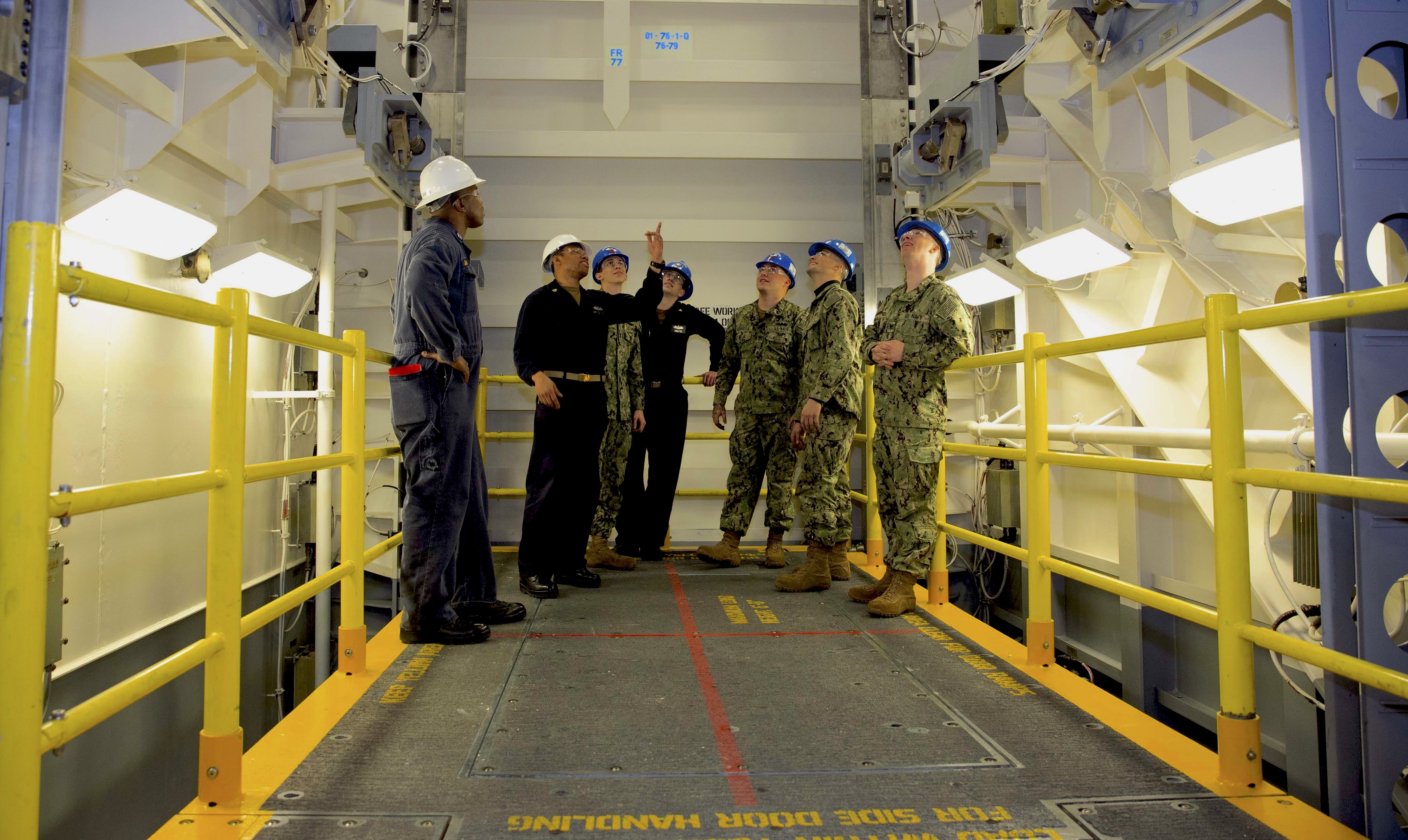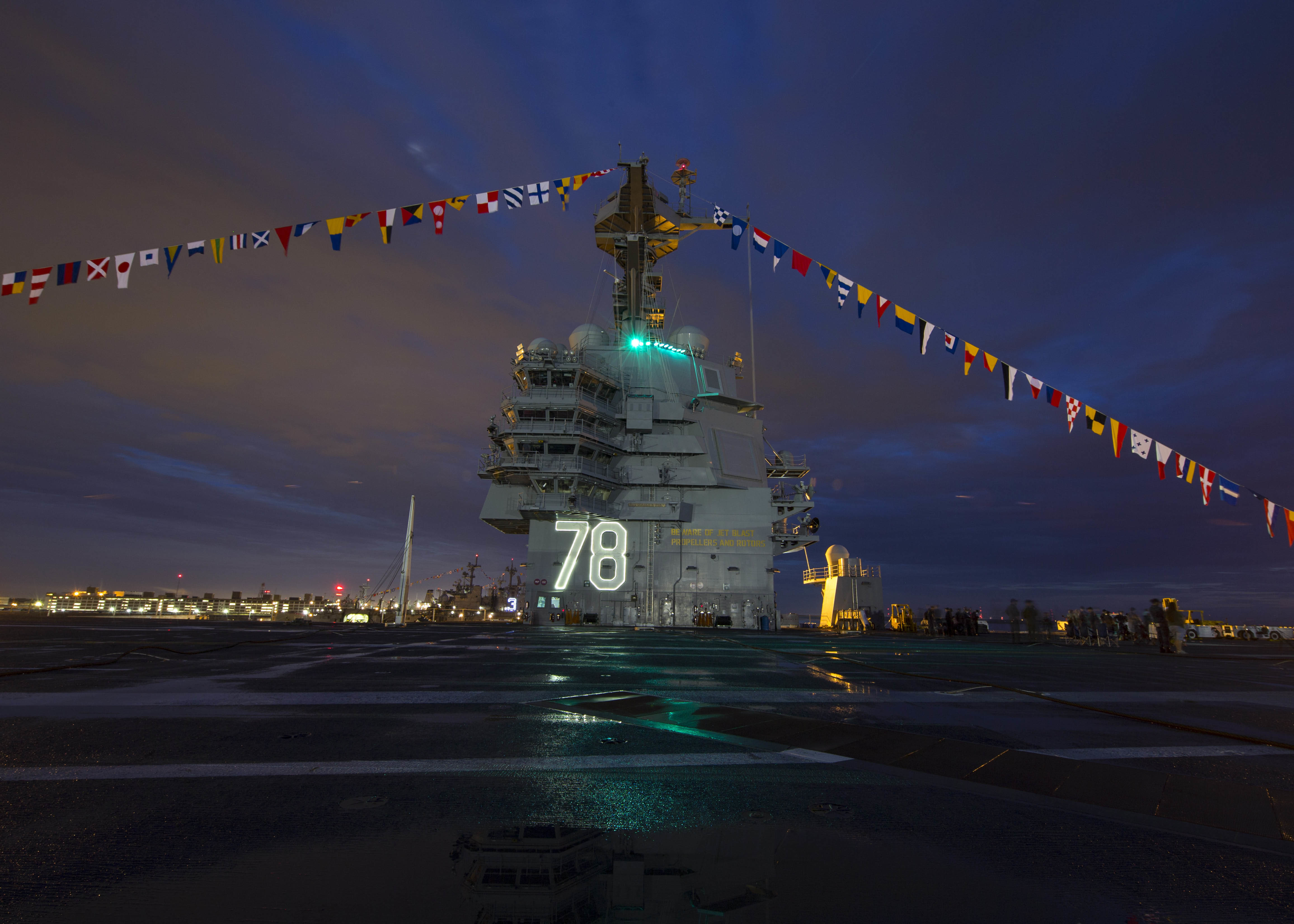USS Gerald R. Ford (CVN 78) displays ‘up and over’ flags in observance of Independence Day in 2017. US Navy Photo
CAPITOL HILL — USS Gerald R. Ford (CVN-78) may not be ready to deploy until 2024, further complicating the Navy’s persistent problems of generating deployable carriers from the East Coast.
Ford’s originally planned deployment date was 2018, but that timeline has continued to slip due largely to developmental delays in the new technologies that were included aboard the first-in-class nuclear aircraft carrier. The delays are also in part due to the Department of Defense’s decision for Ford to undergo full-ship shock trials before its first deployment.
The news of the later deployment date came during a Tuesday House Armed Services readiness subcommittee hearing in an exchange between Naval Sea Systems Command head Vice Adm. Tom Moore and Rep. Elaine Luria (D-Va.).
“The original deployment was 2018 and best estimates we’re looking at 2024?” Luria asked Moore during the hearing.
“I think we’ll beat that,” Moore said. “We’re going to pull back as far to the left as we can, but I think we’re going to beat that.”
The initial estimated deployment date is still under review, pending a decision by Chief of Naval Operations Adm. Mike Gilday in consultation with Moore and James Geurts, assistant secretary of the Navy for research, development and acquisition, Geurts told reporters following the hearing.
“I want to make sure the new CNO has got an opportunity to review that plan and make sure he and I are both comfortable with it,” Geurts told USNI News after the hearing.
Luria, a former surface warfare officer and guided-missile cruiser executive officer, peppered the pair with specific questions on the Navy’s lack of East Coast deployable carriers.
Saying Ford is currently a “$13-billion nuclear-powered floating berthing barge,” she highlighted the ongoing carrier readiness issues at Norfolk that include: the delay in deploying USS Harry S. Truman (CVN-75) due to emergent electrical problems, the two-plus-year maintenance period for USS George H.W. Bush (CVN-77) and the long-extended availability of USS Dwight D. Eisenhower (CVN-69) that left the carrier unable to relieve USS Abraham Lincoln (CVN-72) in the Middle East and forced Truman into a double pump deployment.
She highlighted that there were only two yards in the U.S. that were capable of repairing the Navy’s domestic nuclear carriers and that the Navy’s Optimized Fleet Response Plan that was supposed to provide the Navy the ability to surge forces in case of emergency has been ineffective.
“We’ll have to extend the Lincoln on deployment because of one casualty on one carrier?” she asked Moore.
“Do we have the capacity we need between Norfolk Naval Shipyard and Puget Sound to do the work that we need?”
“We absolutely do,” he said.
Geurts and Moore did stress to panel the importance of the Navy’s $21 billion plan to improve the service’s four public shipyards. In a statement following the hearing, a spokesman for Geurts said it would help carrier readiness to pass budgets on time and limit the uncertainty of continuing resolutions.

Sailors go over safety procedures for the Upper Stage 1 advanced weapons aboard USS Gerald R. Ford (CVN-78). US Navy Photo
Moore and Geurts also updated the committee on the ongoing certification of Ford’s electromagnetic Advanced Weapons Elevators. The third AWE has been certified for use, leaving eight more to undergo certification.
Geurts told reporters following the hearing that the issues were largely construction-related and the technology has proved effective.
“We certified now and turned over to the crew three elevators. The fourth one is very close,” he said.
Ford is set to leave Norfolk Naval Shipyard at the conclusion of its post-shakedown availability at the end of the month, and the remaining elevators will be certified over the next 18 months, Geurts said.
“There’s a lot of detailed planning right now in terms of how to most efficiently get that work done, given that the ship is going to be out to sea a good amount of time,” he said.
“We’re about 75 percent done with the entire project. We’re talking about in some cases [lining up] 70-ton doors and hatches. It’s not a technology issue. It’s a construction completion issue in terms of getting all the doors and hatches where they need to be.”

